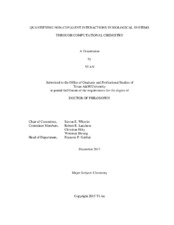| dc.description.abstract | Non-covalent interactions, especially those involving arenes, perform critical roles in biological processes, including ligand-protein and ligand-nucleic acid interactions, as well as protein and DNA/RNA stability and function. We investigated non-covalent interactions involving aromatic rings using computational chemistry in four contexts: sequence-selective DNA-binding antibodies, nitroarene-protein interactions, heterocycle-adenine interactions, and the tuning of amino acid pKa’s. We first surveyed recent advances in our understanding of alkali metal cation-π interactions and their role in both experimental and theoretical fields. Then quantum mechanical computations and classical molecular mechanics based molecular dynamics simulations were utilized as the main tools to explore non-covalent interactions involving π-system in biological systems.
We present computational analyses of the binding of four dinucleotides to a sequence-selective single-stranded DNA (ssDNA) binding antibody (ED-10) and selected point-mutants using MMGBSA as well as DFT applied to a cluster model of the binding site. The results indicate that the sequence selectivity arises primarily from differences in the strength of π-stacking and XH/π interactions with the surrounding aromatic residues; hydrogen bonds play little role.
Stacking interactions in nitroarene binding sites of proteins were studied through analyses of structures in the protein data bank (PDB), as well as DFT and ab initio computations applied to model systems. The results show that the interactions between aromatic amino acids and nitroarenes are very strong, and the regiochemistry of the nitro substituents plays a significant role in the relative monomer orientations and strength of the interaction.
Next, complexes of 9-methyladenine with 46 heterocycles commonly found in drugs were studied using dispersion-corrected density function theory, revealing 268 unique stacked dimers. The predicted binding energies for each heterocycle span a broad range, highlighting the strong dependence of heterocycle stacking interactions on the relative orientation of the two arenes. The data reveal several key local, direct interactions that strongly influence the preferred orientation and strength of the most favorable stacked complexes.
Finally, the impact of π-stacking interactions on the pKa of ionizable amino acid side chains was investigated by DFT computations. π-stacking interactions, edge-to-face interactions, CH/π interactions, and NH/π interactions abound in these complexes, and impact the acidity of these ionizable groups. | en |


